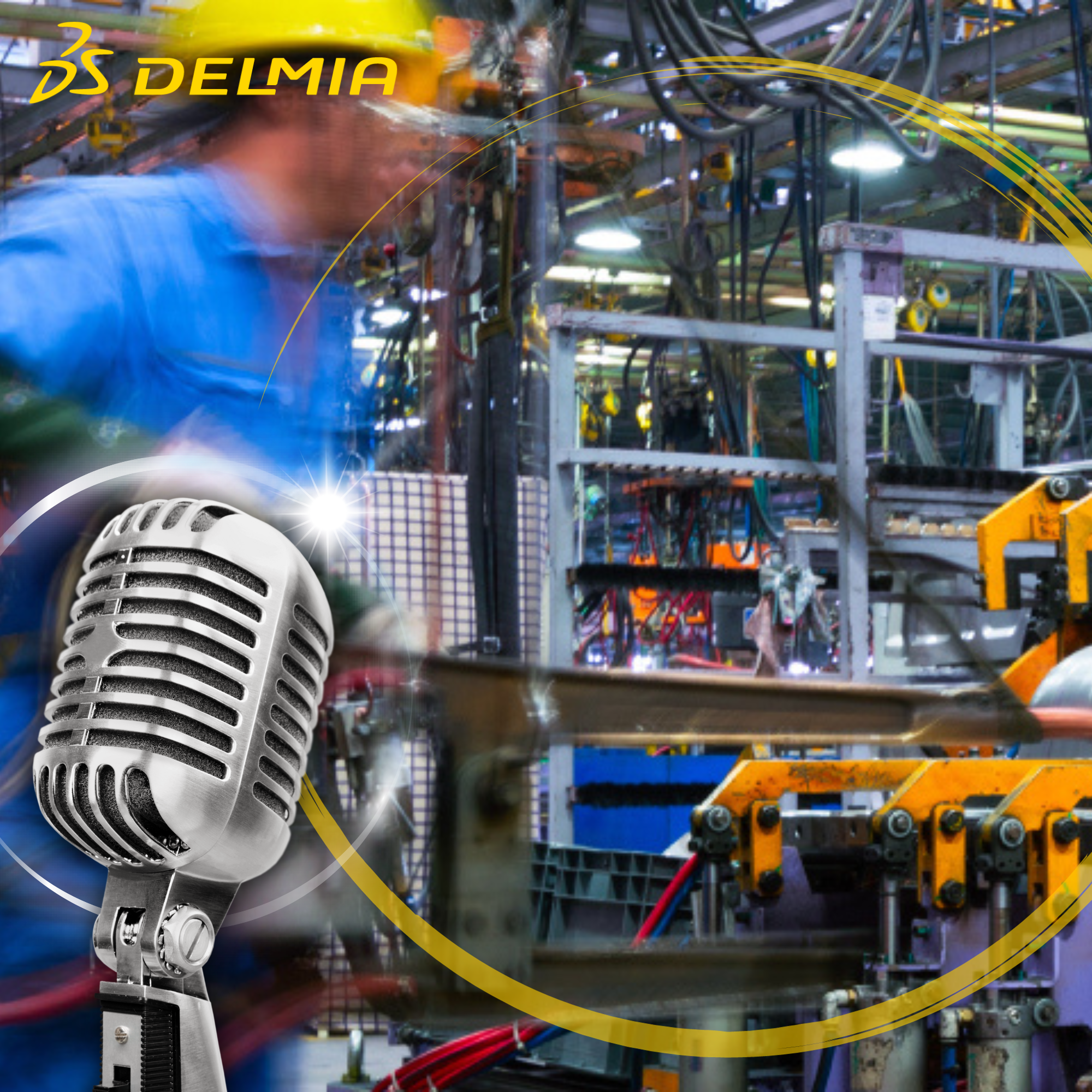Ep: 22 Transforming Manufacturing Engineering
In episode 22, Adrian Wood, DELMIA Strategic Business Development Director, Dassault Systèmes, discusses Virtual Build. Tune in as he provides valuable and strategic insight on transforming manufacturing engineering.
The benefits, possibilities and future of virtual build
Adrian Wood elaborates on a 3-part webinar series with Tech-Clarity. Listen in as he discusses virtual build and transforming manufacturing engineering. You’ll also have the opportunity to gain an in-depth look at the following:
- Webinar 1: What are the challenges of Transforming Manufacturing Engineering with Virtual Technology? https://go.3ds.com/VirtualBuild1
- Webinar 2: Understanding the Capabilities & Opportunities of Transforming Manufacturing Engineering with Virtual Technology https://go.3ds.com/VirtualBuild2
- Webinar 3: What are the Possibilities and Future of Transforming Manufacturing Engineering with Virtual Technology? https://go.3ds.com/VirtualBuild3
Meet Our Speaker
Adrian Wood
You can follow the DELMIA "Global Operations on the Go" podcast on Apple podcasts, Spotify, YouTube Podcasts, Deezer, by RSS or wherever you get your podcast


![]()


Delivering More Complicated and Personalized Products
00:05 Adrian Wood
Hi, this is Adrian Wood from the DELMIA brand. I'm Director of Strategy & Business Development, and today I'm talking to you on this podcast about the topic of transforming manufacturing engineering or more commonly known as virtual build. This process is key to companies in all different industries and is a key part of becoming more efficient. And the challenge that companies are facing is they're under increasing pressure to deliver more complicated and personalized products based upon consumer demand, trying to get into market faster.
And of course, as the pace of the demand changes, so must the pace of the relevant departments internally; design, engineering and manufacturing. And it's a challenge to maintain high levels of quality without incurring the additional costs and delays that might be thrown at the problem without having a different way or a better level of efficiency, addressing those challenges.
The Digital Divide
01:07 Adrian Wood
One of the critical parts of the challenge is what's known as the digital divide that exists between these key stakeholder departments, engineering and manufacturing, and design. And it's the key step which determines whether companies can actually build what has been designed in an efficient and sustainable manner. So these organizations, or divisions within organizations need to collaborate seamlessly, but the trouble is, they're often working in silos, not just silos from an organizational point of view, but from a process and a data point of view as well. So this virtual build process focuses on the technology, the people and the process that can help bridge this gap and enable companies to achieve the goals of satisfying this endlessly increasing complexity of customer demand, and capturing market share without sacrificing the profit or quality.
DELMIA and Tech-Clarity
02:03 Adrian Wood
To help us answer some of these questions and look at the challenges, DELMIA asked Tech-Clarity to help out. Tech-Clarity is an independent research firm that looks at the way companies invest in software technology, how they achieve better business results and truly make the business value of technology clear to manufacturers. And this is an area that they have a special focus on. So, Jim Brown has joined us for a lot of the discussion. He's the President and Co-founder of Tech-Clarity and covers the digital enterprise and this space specifically. What we've done with Tech-Clarity is to ask them to develop a survey, which looks at how companies are challenged in this area, some of the solutions and capabilities that they've put in place and some of the steps they're taking to develop better, more efficient processes.
So, if we look at some of the analysis they've done and summarize some of the challenges, some of the key challenges we've seen in organizations are the fact that there's a lot of data duplication across manufacturing facilities to engineer the process across different organizational silos. But there's no virtual validation of the process feasibility, which means that companies are still relying upon manual or physical prototypes to try and solve this problem, which is inefficient and expensive. There's disparate process engineering tools across different plants. It's difficult to capitalize on best practices because of the siloed nature of the work. And there's a significant workload of additional manual process to create and maintain things like assembly drawings.
And of course, that means that it's very rare companies have up-to-date product information for the manufacturing process, assembly process, and for the machine and manufacturing shop floor work and instructions. From a capabilities point of view, DELMIA provides a number of different solution areas that would help in this process; validation and simulation to validate the product builder, process plan definition so you can look virtually at the most optimal way that process plans and routings can be developed, and then creation of the manufacturing bill of materials from the engineering bill of materials and the process between.
So, looking at how we can add manufacturing information to the engineering bill of materials, like sub-assemblies and kits, how you can visualize that in three dimensions, make sure that everything is consumed effectively. Full process plan visualization, so we can see the flow of steps and do a true virtual builder through visualizing in three dimensions the workstation steps and how we put product together and also managing more effectively all the engineering changes and synchronizing the digital thread between different departments.
So, this helps enable the DFX process, design for––design for engineering, design for manufacturing, so that there's collaboration truly between the designers, engineers and manufacturers and there's a feedback loop and communication and collaboration, manufacturing simulation so that you can check for things like interference checking during the assembly process in a virtual world, making design changes that can be replayed over and over in different environments, again in a virtual three dimensional environment, and documenting issues and feedback so that everyone gets on the same page.
The Benefits to Increasing Maturity Level of Processes
05:26 Adrian Wood
There's a lot of benefits to increasing the maturity level of the entire process for digital manufacturing. Concurrent engineering allows for work to be done in parallel, so it can shorten the product cycle, and delivery times and speed to market. It also gives early analysis of potential manufacturing problems and alternate manufacturing strategies and provides a level of data consistency. And these simulation tools help companies scale so you can look at different scenarios for process definition, maximize throughput on the shop floor before you even develop anything in the physical world.
It also allows for the management of different diversities of configuration for these complex products, which all industries are being asked to build, and accelerates the overall process speed so that we enrich data versus duplicate it. And we have a model-based approach for all disciplines. So the survey that Tech-Clarity developed went out to almost a couple of 100 different people and companies directly involved with manufacturing engineering across all different industries. They found there was a lot of valuable information gained from the feedback that was developed out of the survey.
For example, in terms of the challenges that process designers faced, there were several key metrics around wasted time or non-value-added activities, like the time spent searching for data or rekeying information, manual processes that a digital model-based enterprise really can address and solve, documenting feedback and other activities. And in fact, on average, they said about 25% of manufacturing engineering time is spent on these very manual non-value-added activities. The survey also looked at what makes a top performer in terms of their maturity in terms of process, technology and people around the manufacturing engineering process, and what they're likely to achieve in terms of benefits.
So, they're more likely to find issues early in product and process design, as opposed to finding things downstream or the in physical world. Top performers tend to use 3D simulation virtual twins to improve manufacturing engineering, and they look at integrated connected platforms to help them manage the overall process from end to end. And there's tangible cost saving benefits and time saving benefits that we’ve seen as well. 70% less time on non-value-added activities for top performers, 38% less prototypes, which are physically expensive and take a lot of time to develop, and a massive amount of savings per product overall in terms of the process. This is a really critical process for most companies, whether in high tech or transportation, aerospace, it doesn't really matter what industry you're in, if you're developing complex products, there are challenges, yet benefits and opportunities to be had.
Download the Webinars to Learn More
08:24 Adrian Wood
If you'd like to learn more about this, you can find the links below this podcast in the comments about the webinars that we did, there were three webinars we created, short discussion-oriented webinars talking about the challenges, the capabilities and some of the survey results. And in fact, very shortly, we'll be able to provide you with a link for the eBook that Tech-Clarity is developing, and that will have the full set of survey results. So as always, we'd love to continue the conversation with you. We'd love you to connect with the DELMIA organization.
Look for the comments below to replay the webinars and some of the information in the discussions that we've had with Tech-Clarity and Jim Brown, and look for the upcoming eBook where you can get access to the full set of survey results and read in-depth about some of the challenges and some of the opportunities related to transforming manufacturing engineering. Thanks again.


